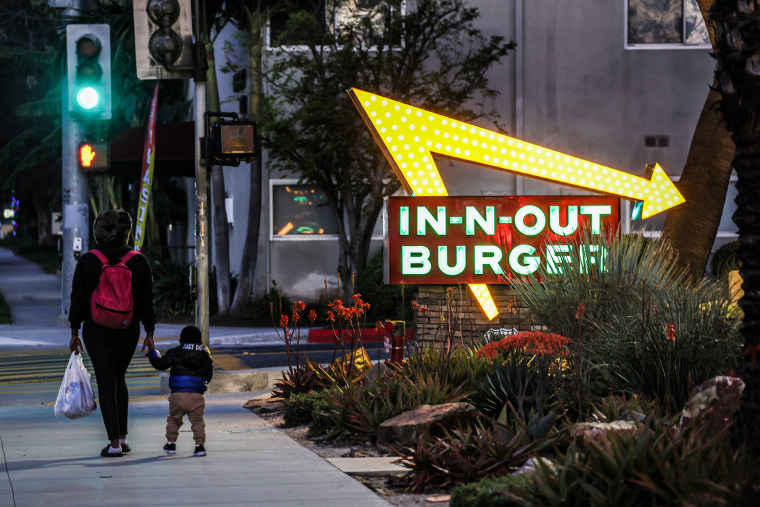
How In-N-Out Burger’s president runs her fast-food empire: Keep it simple, affordable and close

In-N-Out isn’t your typical burger joint, and it insists expanding its footprint won’t change that.
For nearly eight decades, the West Coast restaurant chain has remained a private, family-owned company that has cultivated fiercely loyal customers and a quirky identity despite being located in just a handful of states. But recently it’s been on a growing spree that will soon extend as far east as Tennessee.
Since Lynsi Snyder took over as the California-based company’s president in 2010, its size has nearly doubled, from 230 stores in four states to 402 in eight. In-N-Out Burger is opening in Washington, its ninth state, with New Mexico and Tennessee to follow.
Snyder said she’s still cautious about expanding too far or too fast and remains focused on keeping prices lower than competitors’. Even before taking the reins, she said she “felt such an obligation to look out for our customer. When everyone else was taking these jumps, we weren’t.”
That could be an advantage as the burger wars adapt to an economy still fitfully coming down from a historic run-up of inflation.
Some major fast-food franchises saw underwhelming sales late last year as many diners veered away from drive-thrus to seek better value in grocery aisles. In February, Wendy’s hastened to “clarify” its plan to roll out “dynamic pricing” after customers complained it would mean pricier burgers and fries during busier times.
At In-N-Out, a Double Double — two beef patties with two slices of cheese — sells for anywhere from $5.90 to $6.05 in California, the company said.
Unlike In-N-Out, bigger fast-food rivals are franchised, allowing individual store operators to set their own prices, which can often run higher for similarly sized sandwiches. When NBC News recently placed online pickup orders at the closest McDonald’s, Wendy’s and Burger King locations to the same central Los Angeles address, a Big Mac cost $6.59, a Dave’s Single $6.29, and a Whopper $6.49, respectively.
In-N-Out still uses many of the same wholesalers Snyder’s grandfather used in the 1940s and ’50s, she said. It’s one reason the company has expanded so deliberately; moving into a new region can require striking up new relationships with untested vendors, which risks compromising on quality, price or both.
The company isn’t bucking industry trends with its growth plans. Major quick-service restaurants are also expanding, with McDonald’s, the Chicago sandwich chain Portillo’s and others chasing sales growth by shifting their geographical footprints. But while some larger brands are targeting the Sun Belt, where the populations of several states and cities have swelled since the pandemic, Snyder said In-N-Out is keeping its center of gravity on the West Coast.
That could pose some business challenges, especially in California, where restaurant operators say a new minimum wage for fast-food workers makes it harder to keep menu items affordable. The requirements, which took effect this month, mean companies with at least 60 national locations must pay workers at least $20 an hour. Some have responded by slashing their workforces in the state and warning they’ll pass higher labor costs to diners.
In-N-Out, however, was already paying associates about $20 to $21 an hour. Since the mandated hike, the company said it has increased that range to $23 to $24.
“We want them to go the extra mile to take care of our customers, so we want to pay them well,” Snyder said. “I’m going to take care of them.”
Still, In-N-Out Burger joined a restaurant industry coalition that opposed the California pay law. The company contributed over $12.8 million to Save Local Restaurants, a group that sought to overturn the fast-food minimum wage, according to disclosures the company filed with state authorities. That effort was mooted, though, after the restaurant industry brokered a deal with labor leaders last fall, clearing the way for the pay hike to take effect.
Snyder declined to comment on the campaign against the wage law. A spokesperson for the company said: “In-N-Out Burger takes pride in offering all associates competitive salaries and wages, bonuses for managers and consideration for promotion from within the organization for qualified associates.”
Snyder’s grandparents founded In-N-Out Burger in 1948 as a tiny stand with a pioneering drive-thru speaker system on what were then the rural outskirts of Los Angeles. The company expanded regionally in the decades that followed, but by the time Lynsi was 17, a series of family tragedies had left In-N-Out without a Snyder at the helm. She started at the company by working the register at a new location in Redding, California, and ascended through various departments — including meat and merchandising — before taking control a decade later.
“There’s a stigma that can come with being the owner’s kid,” Snyder said. “I think that wanting to be respected, doing it the right way and not having this special treatment is where my mind was.”
She credits that experience with helping her gain confidence to do things her way — like proudly displaying Bible verses on In-N-Out packaging, or passing up certain tech trends. She has said “no to mobile ordering,” for instance, “because that greatly impacts the customer service experience.”
“There’s a lot of things that could be cheaper, easier, but that’s not the system we go through,” Snyder explained.
She expects the company to stay private, adding that she’s turned down many would-be buyers. Franchising? Also not going to happen. Snyder said she wants the family legacy to continue, especially now that her eldest son has jumped into the business.
“Just seeing him in his uniform, it’s hard to not be a little bit emotional and wish that my dad or my uncle could see him,” she said.
And despite the eastward expansion plans, she said hungry New Yorkers shouldn’t hold out for an In-N-Out in Times Square.
Asked whether the East Coast is on the table, Snyder said, “As long as I’m around, I’m probably saying never.”
